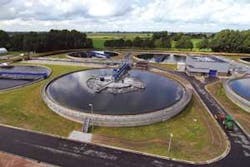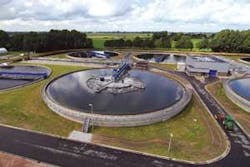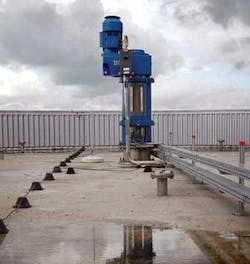Getting the Mix Right
By Pascal Tesser
ABS agitator solution for sewage solids digesters in the Netherlands aids sludge reduction, biogas recovery, and improved maintenance costs and energy consumption.
When a Dutch wastewater treatment plant needed to increase efficiency of its sludge fermentation towers, ABS provided a mix of reduced energy consumption of the plant and minimal maintenance costs. And if that wasn’t enough, the amount of produced admissible solids was doubled.
Besides purification of wastewater from the city of Groningen and the surrounding boroughs, the Garmerwolde wastewater treatment plant also has a sludge processing line for both its own purification process and those of other treatment plants in the area.
Expensive Process
In the purification process, sewage water is cleansed so that it can be discharged into area surface waters. Using a biological process, organic substances in the wastewater are decomposed into natural substances.
Residue from this process is called sludge and is incinerated which is normally expensive due to the high amount of water in the sludge. Therefore, it’s important to decompose the solid material even further and to drain off as much water as possible.
Essential Sludge Mixing
A combination of bacteria and high temperature takes care of the continued decomposition of the solid material in so called sludge fermentation towers. Fermentation also produces biogas, which can be reused to generate energy for the purification process.
To make the sludge decomposition and biogas production as efficient as possible, it’s essential the sludge in the fermentation towers is mixed well. If the mix isn’t adequate, solid particles in the sludge will sink and form a thick layer at the bottom of the towers.
Engineered Solutions
The sludge fermentation process at the Garmerwolde wastewater treatment plant wasn’t optimal – the maximum admissible solid percentage was only 3-4%. Thus, the local water board turned to ABS to improve the process.
The solution was to equip the 5-million-litre digesters each with one ABS Scaba agitator, developed for this purpose. With a shaft length of about 13 meters and other design advantages, the agitators are able to mix the whole contents of the tower, preventing layer forming on top and sedimentation of solid material at the bottom.
The water board was supported by a specialised ABS team of technicians and a project manager during execution of the test and during installation. One of the challenges was to adjust the drive shaft correctly, as there’s no margin for imbalance of any kind in an agitator of this length and size. The seal had to be perfect as well, due to danger of explosion if gas happens to escape.
Improved Efficiency
The extremely high mixing efficiency of the agitator increases the admissible solid percentage to 8-10%. Besides the greatly improved process results, an added advantage is the saving in energy consumption and the minimizing of maintenance costs in the digesters.
Author’s Note:
Pascal Tesser is a sales engineer at Sweden-based ABS Group. With expertise in pumps, mixers, aeration systems, control and monitoring equipment and services, ABS focuses on fluid transport and treatment in the three major market segments of building services, collection networks and treatment plants with countless customers in over 100 countries worldwide. Contact: www.absgroup.com


